Characteristics of Hydrocarbon-Generating Pressurization in Shale Series of Fengcheng Formation in the West and South of Mahu Sag, the Junggar Basin, China
Abstract
:1. Introduction
2. Geological Condition
3. Methods
3.1. Method for Obtaining Shale Compaction Curve
3.2. Experiments and Prediction Method of Total Organic Carbon
3.3. Prediction Method of HGP
4. Results and Discussion
4.1. Shale Compaction Curve and Formation Pressure Characteristics
4.2. Shale Organic Matter Abundance and Source Rock Distribution
4.2.1. Organic Matter Abundance of Shale
4.2.2. Distribution Characteristics of Source Rocks
4.3. HGP Characteristics of the Shale Series in Fengcheng Formation
4.3.1. The Relationship between Key Parameters and HGP
4.3.2. Characteristics of Key Parameters
4.3.3. HGP Characteristics
4.4. Microdistance Migration and Accumulation Model of Oil in the Fengcheng Formation Shale Series
4.4.1. Reservoir Physical Characteristics
4.4.2. Geochemical Characteristics of Oil
4.4.3. Microdistance Migration and Accumulation Model of Oil
5. Conclusions
- (1)
- The Permian Fengcheng Formation shale in the west and south of Mahu Sag does not exhibit obvious undercompaction characteristics, and HGP should be the main cause of overpressure in the Fengcheng Formation shale series.
- (2)
- The logging data of Fengcheng Formation is related to the measured organic matter abundance of the shale source rocks and can be used to predict the organic matter abundance of the shale source rocks. The predicted organic matter abundance and thickness of the source rocks gradually decrease from the east to the west.
- (3)
- The ΔP of shale series in Fengcheng Formation is related to the hydrocarbon generation capacity and overpressure preservation conditions. The ΔP can be quantitatively predicted by comprehensively using the TOC′, Ro, Hs, and r. The ΔP of the shale series in Fengcheng Formation also has a distribution characteristic of gradually decreasing from the east to the west.
- (4)
- The oil reservoirs’ forming mode of the Fengcheng Formation shale series is the microdistance migration and accumulation model driven by the overpressure. It can be further divided into the oil reservoirs’ forming mode of weak overpressure and low production and the oil reservoirs’ forming mode of strong overpressure and high production.
Author Contributions
Funding
Data Availability Statement
Conflicts of Interest
References
- Zhang, Y.; Li, W.; Tang, W. Tectonic setting and environment of alkaline lacustrine source rocks in the lower permian Fengcheng Formation of Mahu sag. Xinjing Pet. Geol. 2018, 39, 48–54. [Google Scholar]
- Zhang, Z.; Yuan, X.; Wang, M.; Zhou, C.; Cheng, D. Alkaline-lacustrine deposition and paleoenvironmental evolution in permian Fengcheng Formation at the Mahu sag, Junggar Basin, NW China. Petrol. Explor. Dev. 2018, 45, 1036–1049. [Google Scholar] [CrossRef]
- Zhi, D.; Tang, Y.; He, W.; Guo, X.; Zheng, M.; Huang, L. Orderly coexistence and accumulation models of conventional and unconventional hydrocarbons in lower permian Fengcheng Formation, Mahu sag, Junggar Basin. Petrol. Explor. Dev. 2021, 48, 43–59. [Google Scholar] [CrossRef]
- Zhi, D.; Tang, Y.; Zheng, M.; Xu, Y.; Cao, J.; Ding, J.; Zhao, C. Geological characteristics and accumulation controlling factors of shale reservoirs in Fengcheng Formation, Mahu sag, Junggar Basin. China Petrol. Explor. 2019, 24, 615–623. [Google Scholar]
- Kuang, L.; Tang, Y.; Lei, D.; Chang, Q.; Ouyang, M.; Hou, L.; Liu, D. Formation conditions and exploration potential of tight oil in the Permian saline lacustrine dolomitic rock, Junggar Basin, NW China. Petrol. Explor. Dev. 2012, 39, 657–667. [Google Scholar] [CrossRef]
- Liu, B.; Shi, J.; Fu, X.; Lv, Y.; Sun, X.; Gong, L.; Bai, F. Petrological characteristics and shale oil enrichment of lacustrine fine-grained sedimentary system: A case study of organic-rich shale in first member of Cretaceous Qingshankou Formation in Gulong Sag, Songliao Basin, NE China. Petrol. Explor. Dev. 2018, 45, 828–838. [Google Scholar] [CrossRef]
- Zheng, M.; Li, J.; Wang, W.; Li, P.; Yang, H.; Wu, X.; Yu, J. Analysis of Oil Charging and Accumulation Processes in Tight Reservoir Beds: A Case Study of Lucaogu Formation in Jimsar Sag of Junggar Basin, NW China. Earth Sci. 2018, 43, 3719–3732. [Google Scholar]
- Guo, X.; He, S.; Liu, K.; Song, G.; Wang, X.; Shi, Z. Oil generation as the dominant overpressure mechanism in the Cenozoic Dongying Depression, Bohai Bay Basin, China. AAPG Bull. 2010, 94, 1859–1881. [Google Scholar] [CrossRef]
- Song, M.; Liu, H.; Wang, Y.; Liu, Y. Enrichment rules and exploration practices of Paleogene shale oil in Jiyang Depression, Bohai Bay Basin, China. Petrol. Explor. Dev. 2020, 47, 225–235. [Google Scholar] [CrossRef]
- Xue, Y.; Ranjith, P.G.; Gao, F.; Zhang, Z.; Wang, S. Experimental investigations on effects of gas pressure on mechanical behaviors and failure characteristic of coals. J. Rock. Mech. Geotech. Eng. 2023, 15, 412–428. [Google Scholar] [CrossRef]
- Wang, L.Y.; Chen, W.Z.; Zhang, Y. Investigating Effects of Heterogeneity and Fracture Distribution on Two-Phase Flow in Fractured Reservoir with adaptive time strategy. Transp. Porous Media 2023, 149, 175–203. [Google Scholar] [CrossRef]
- Liu, H.; Yu, B.; Xie, Z.; Han, S.; Shen, Z.; Bai, C. Characteristics and implications of micro-lithofacies in lacustrine-basin organic-rich shale: A case study of Jiyang depression, Bohai Bay Basin. Acta Pet. Sin. 2018, 39, 1328–1343. [Google Scholar]
- Yang, H.; Liang, X.; Niu, X.; Feng, S.; You, Y. Geological conditions for continental tight oil formation and the main controlling factors for the enrichment: A case of Chang 7 Member, Triassic Yan chang Formation, Ordos Basin, NW China. Petrol. Explor. Dev. 2017, 44, 12–20. [Google Scholar] [CrossRef]
- Fu, S.; Fu, J.; Niu, X.; Li, S.; Wu, Z.; Zhou, X.; Liu, J. Accumulation conditions and key exploration and development technologies in Qingcheng oilfield. Acta Pet. Sin. 2020, 41, 777–795. [Google Scholar]
- Li, J.; Tang, Y.; Wu, T.; Zhao, J.; Wu, H.; Wu, W.; Bai, Y. Overpressure origin and its effects on petroleum accumulation in the conglomerate oil province in Mahu Sag, Junggar Basin, NW China. Petrol. Explor. Dev. 2020, 47, 679–690. [Google Scholar] [CrossRef]
- Feng, C.; Lei, D.W.; Qu, J.H.; Huo, J.Z. 2019. Controls of paleo-overpressure, faults and sedimentary facies on the distribution of the high pressure and high production oil pools in the lower Triassic Baikouquan Formation of the Mahu Sag, Junggar Basin, China. J. Pet. Sci. Eng. 2019, 176, 232–248. [Google Scholar]
- Dewen, L.E.; Abulimiti, T.; Jing, C.H.; Jian, C.A. Controlling factors and occurrence prediction of high oil-gas production zones in Lower Triassic Baikouquan Formation of Mahu Sag in Junggar Basin. Xinjiang Pet. Geol. 2014, 35, 495–499. [Google Scholar]
- Liu, G.; Chen, Z.; Wang, X.; Gao, G.; Xiang, B.; Ren, J.; Ma, W. Migration and accumulation of crude oils from Permian lacustrine source rocks to Triassic reservoirs in the Mahu depression of Junggar Basin, NW China: Constraints from pyrrolic nitrogen compounds and fluid inclusion analysis. Org. Geochem. 2016, 101, 82–98. [Google Scholar] [CrossRef]
- Liang, Y.; Zhang, Y.; Chen, S.; Guo, Z.; Tang, W. Controls of a strike-slip fault system on the tectonic inversion of the Mahu depression at the northwestern margin of the Junggar Basin, NW China. J. Asian Earth Sci. 2020, 198, 104229. [Google Scholar] [CrossRef]
- Hu, T.; Pang, X.; Yu, S.; Wang, X.; Pang, H.; Guo, J.; Jiang, F.; Shen, W.; Wang, Q.; Xu, J. Hydrocarbon generation and expulsion characteristics of Lower Permian P1f source rocks in the Fengcheng area, northwest margin, Junggar Basin, NW China: Implications for tight oil accumulation potential assessment. Geol. J. 2016, 51, 880–900. [Google Scholar] [CrossRef]
- Cao, J.; Xia, L.; Wang, T.; Zhi, D.; Tang, Y.; Li, W. An alkaline lake in the Late Paleozoic Ice Age (LPIA): A review and new insights into paleoenvironment and petroleum geology. Earth Sci. Rev. 2020, 202, 103091. [Google Scholar] [CrossRef]
- Wang, T.; Cao, J.; Carroll, A.R.; Zhi, D.; Tang, Y.; Wang, X.; Li, Y. Oldest preserved sodium carbonate evaporite: Late Paleozoic Fengcheng Formation, Junggar Basin, NW China. GSA Bull. 2020, 133, 1465–1482. [Google Scholar] [CrossRef]
- Xiang, B.; Ma, W.; He, D.; Pan, Y. Heterogeneity of alkaline lacustrine source rocks of the lower Permian Fengcheng Formation in the Mahu Sag, Junggar Basin, northwestern China. Energy Explor. Exploit. 2023, 41, 370–390. [Google Scholar] [CrossRef]
- Yu, K.; Cao, Y.; Qiu, L.; Sun, P. Depositional environments in an arid, closed basin and their implications for oil and gas exploration: The lower Permian Fengcheng Formation in the Junggar Basin, China. AAPG (Am. Assoc. Pet. Geol.) Bull. 2019, 103, 2073–2115. [Google Scholar] [CrossRef]
- Cao, J.; Lei, D.; Li, Y.; Tang, Y.; Wang, T. Ancient high-quality alkaline lacustrine source rocks discovered in the lower permian Fengcheng Formation, Junggar Basin. Acta Pet. Sin. 2015, 36, 781–790. [Google Scholar]
- Xia, L.; Cao, J.; Stüeken, E.E.; Zhi, D.; Wang, T.; Li, W. Unsynchronized evolution of salinity and pH of a Permian alkaline lake influenced by hydrothermal fluids: A multi-proxy geochemical study. Chem. Geol. 2020, 541, 119581. [Google Scholar] [CrossRef]
- Wang, J.; Liu, Y.; Wan, C.; Zhu, X.; Wang, X.; Ge, J.; Zhang, X. Characteristics and origin of dolomitic tuff in the Permian Fengcheng Formation in Wu-Xia area of Junggar Basin. J. Palaeogeogr. 2014, 16, 157–168. [Google Scholar]
- Lei, D.; Abulimit, I.; Qin, Z.; Cao, J.; Chen, G.; Yang, H.; Bian, B.; Zhao, L.; Yao, A. Origin and Occurrence of the Light Oil and Gas in the Alkaline Lake of Mahu Sag, Junggar Basin; China Science Publishing & Media Ltd.: Beijing, China, 2017. [Google Scholar]
- Feng, C.; Li, T.; He, W.; Zheng, M. Organic geochemical traits and paleodepositional conditions of source rocks from the Carboniferous to Permian sediments of the northern Mahu Sag, Junggar Basin, China. J. Petrol. Sci. Eng. 2020, 191, 107117. [Google Scholar] [CrossRef]
- Chen, G.; Wang, D.; Yang, F.; Tang, Y.; Zou, X.; Ma, W.; Li, M. Organic geochemistry and controlling factors of alkaline source rocks within sequence stratigraphic framework in the Fengcheng Formation, Mahu sag, Junggar Basin, NW China. Energy Explor. Exploit. 2022, 40, 1057–1077. [Google Scholar] [CrossRef]
- Yu, K.; Cao, Y.; Qiu, L.; Sun, P.; Jia, X.; Wan, M. Geochemical characteristics and origin of sodium carbonates in a closed alkaline basin: The Lower Permian Fengcheng Formation in the Mahu Sag, northwestern Junggar Basin, China. Palaeogeogr. Palaeoclimatol. Palaeoecol. 2018, 511, 506–531. [Google Scholar] [CrossRef]
- Bowers, G.L. Detecting high overpressure. Lead. Edge 2002, 21, 174–177. [Google Scholar] [CrossRef]
- Bowers, G.L. Pore pressure estimation from velocity data: Accounting for overpressure mechanisms besides under compaction. SPE 1995, 10, 27488. [Google Scholar] [CrossRef]
- Tingay, M.R.; Morley, C.K.; Laird, A.; Limpornpipat, O.; Krisadasima, K.; Pabchanda, S.; Macintyre, R. Evidence for overpressure generation by kerogen-to-gas maturation in the northern Malay Basin. AAPG Bull. 2013, 97, 639–672. [Google Scholar] [CrossRef]
- Lahann, R.W.; Swarbrick, R.E. Overpressure generation by load transfer following shale framework weakening due to smectite diagenesis. Geofluids 2011, 11, 362–375. [Google Scholar] [CrossRef]
- Gao, G.; Liu, S.J.; Jin, J. A new discovery of physical property evolution of crude oil and insights into shale oil exploration. Acta Geol. Sin. 2023, 97, 1561–1575. [Google Scholar]

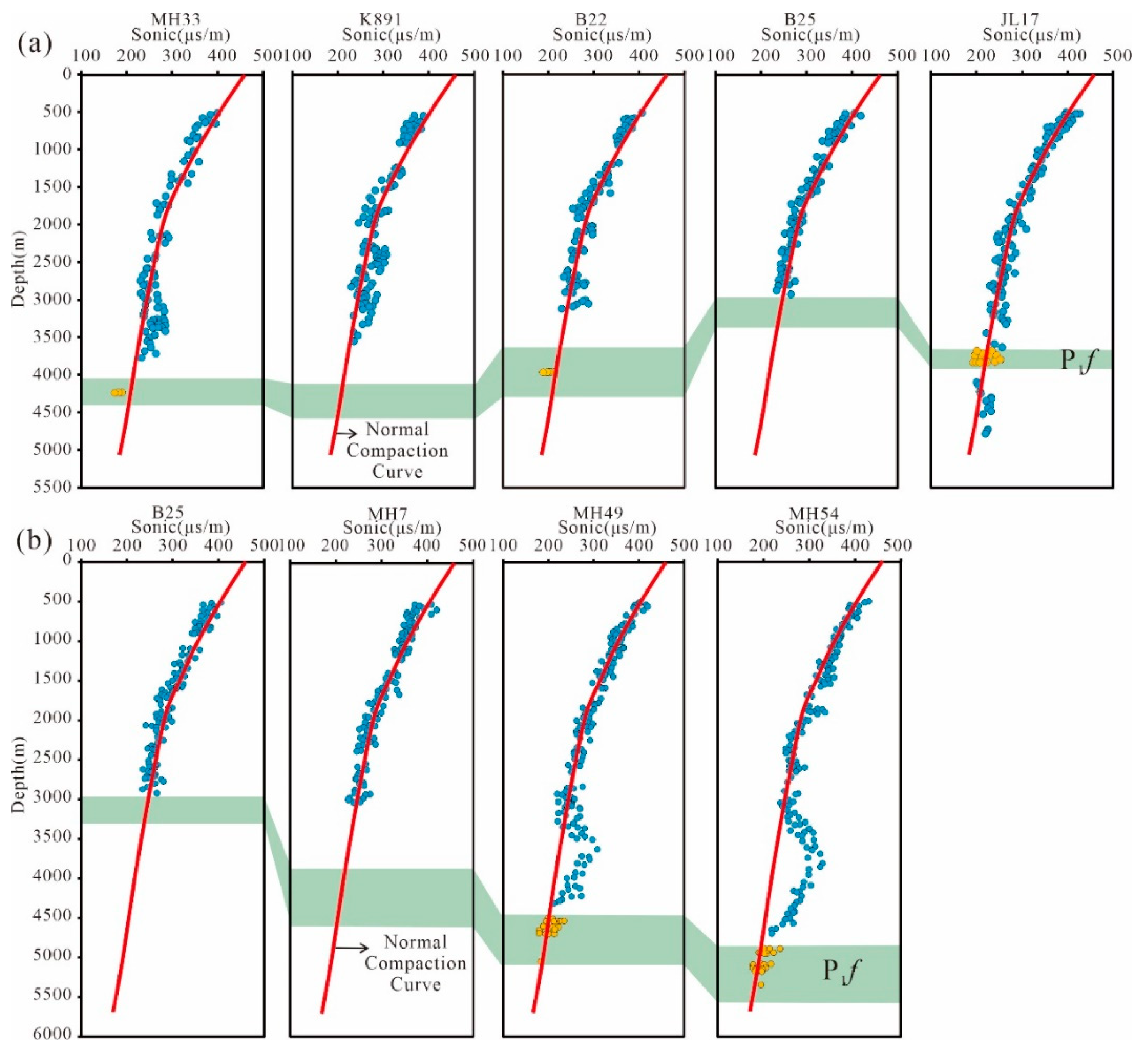
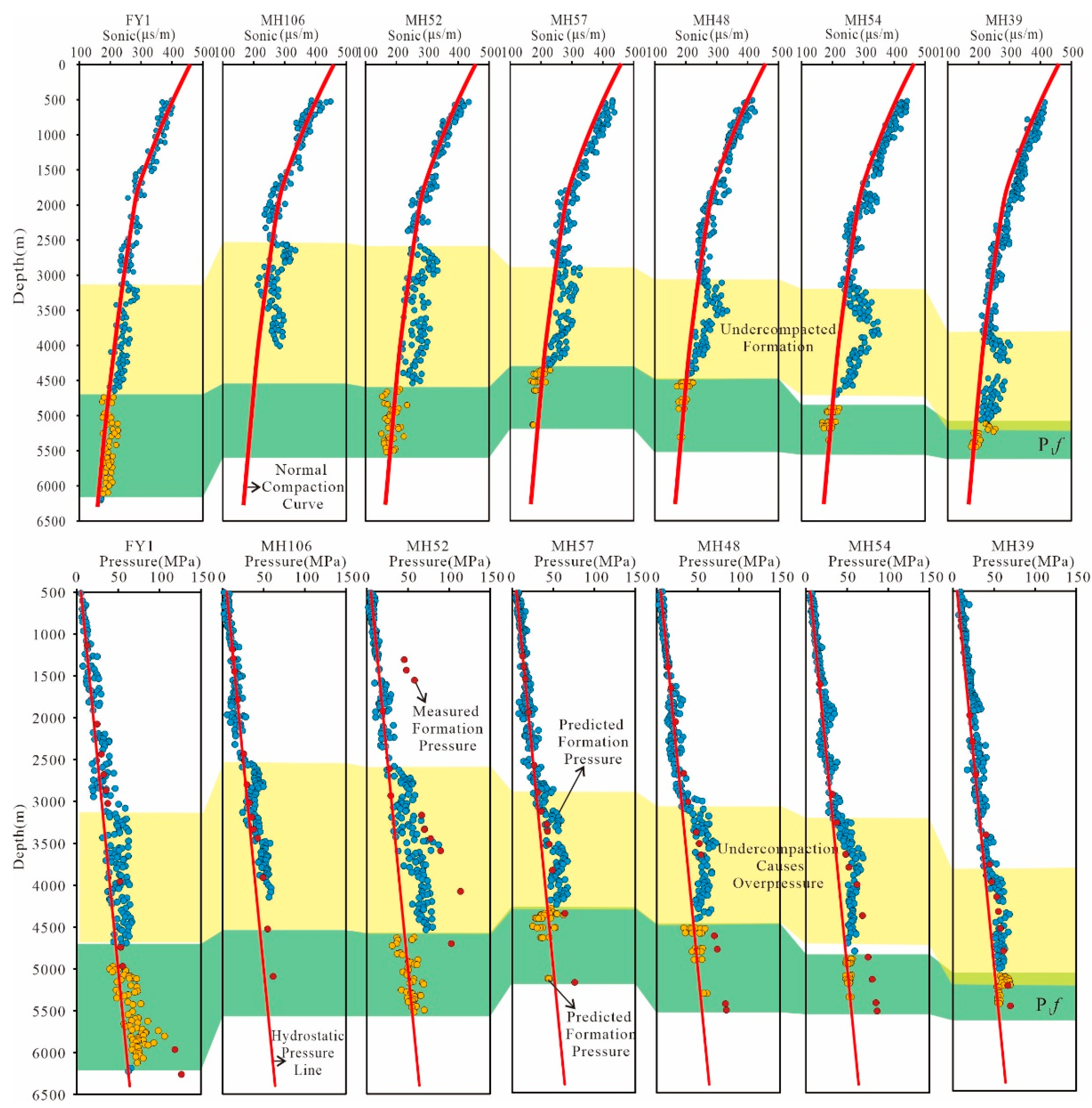


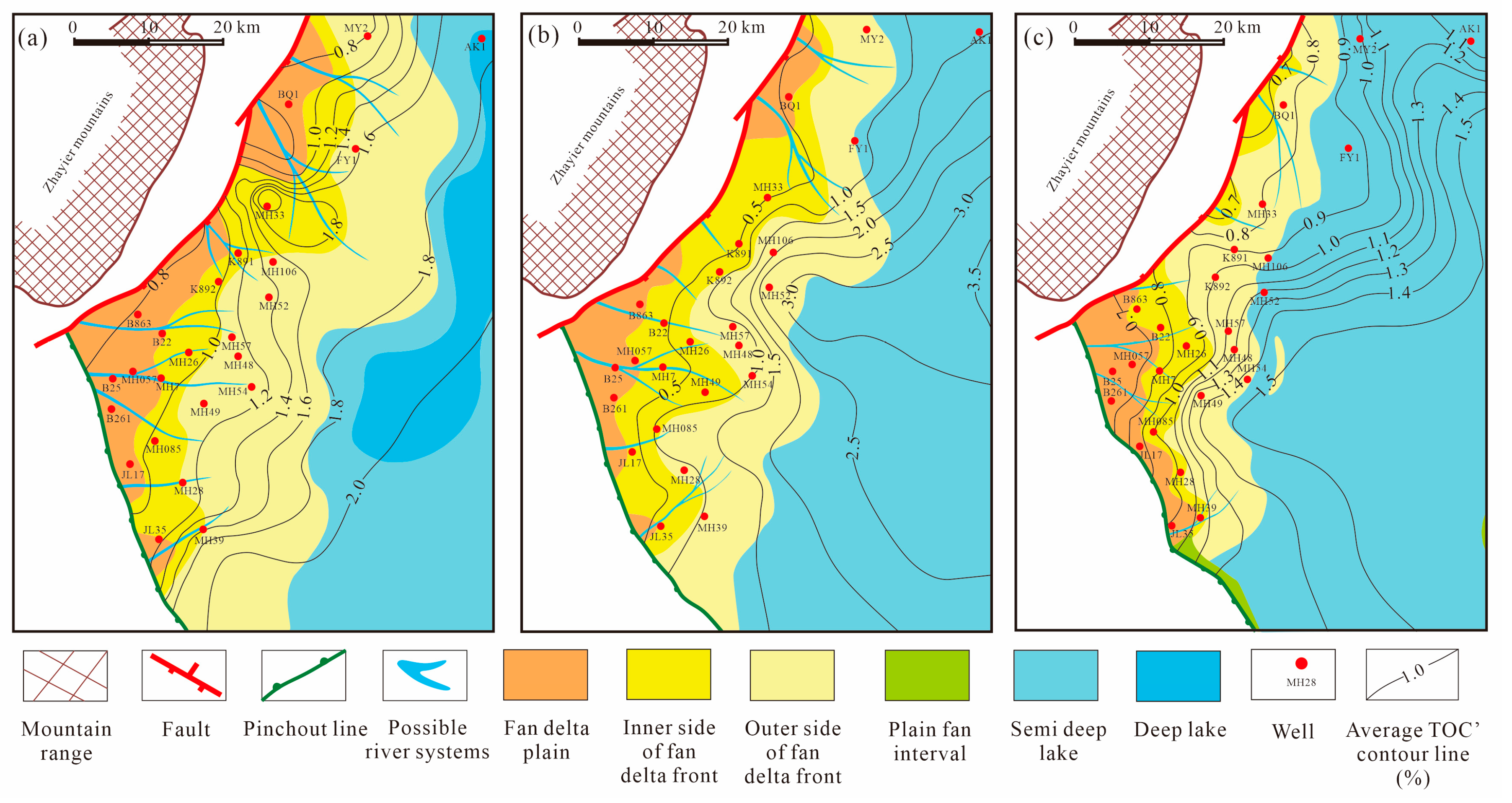

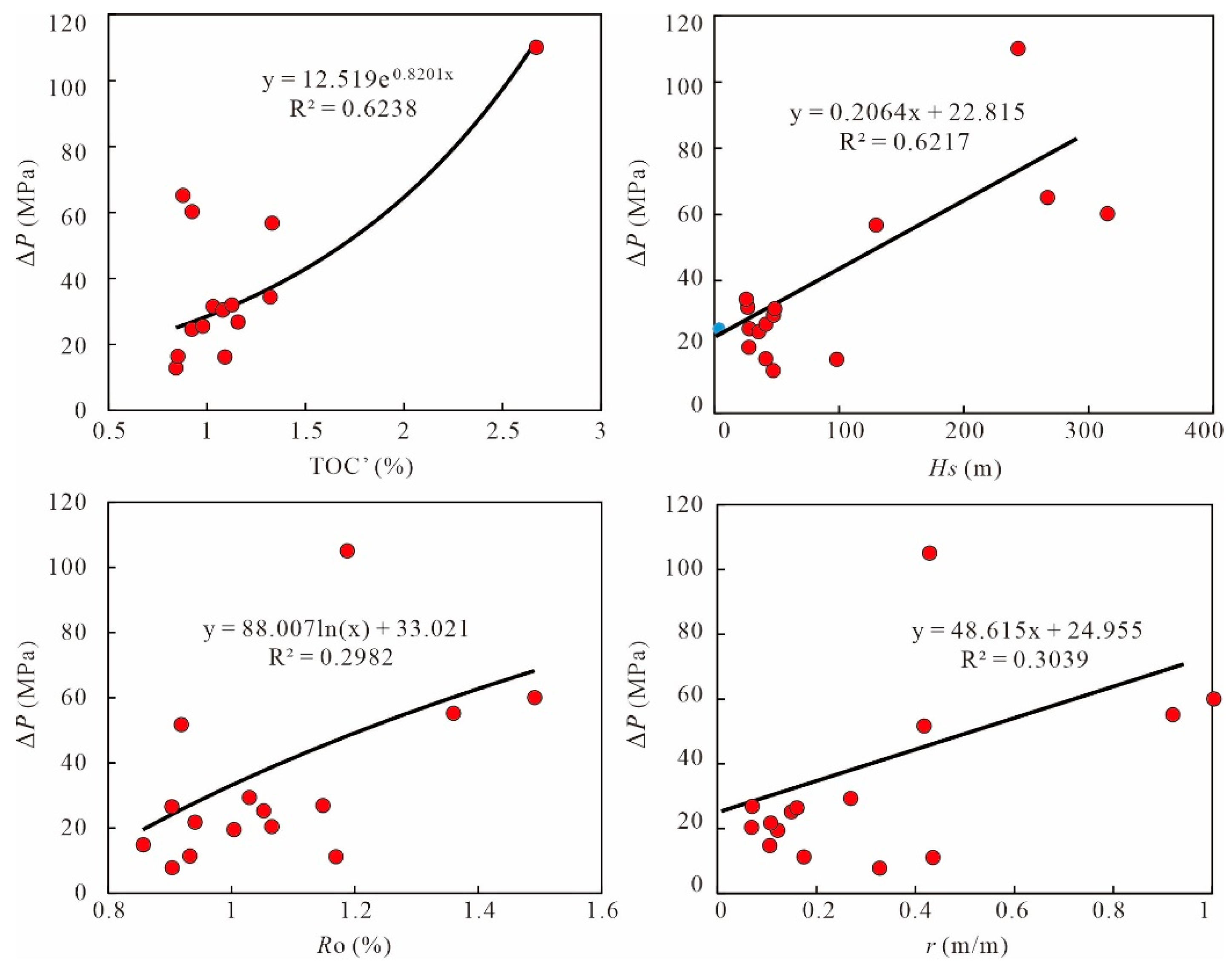

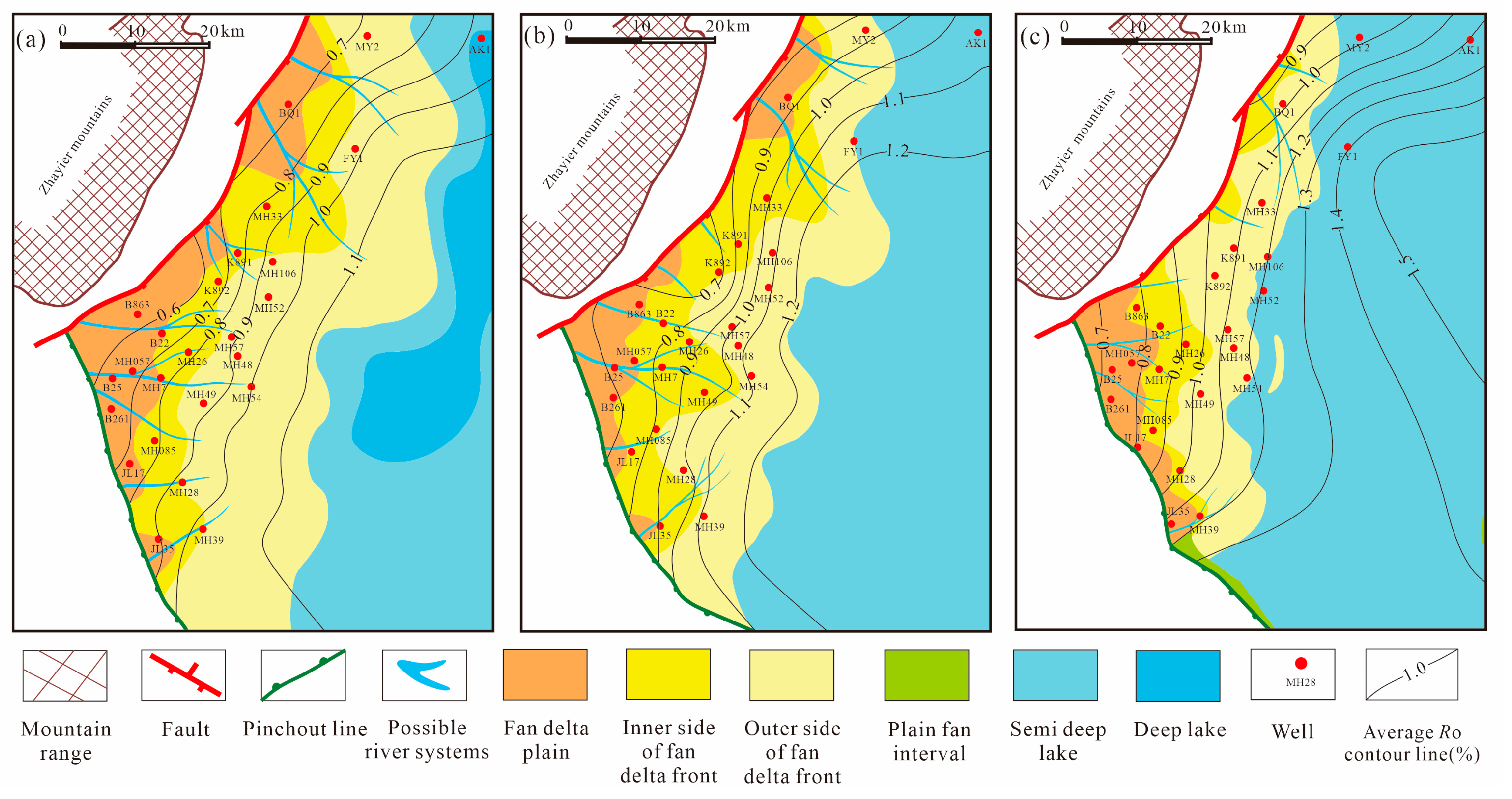
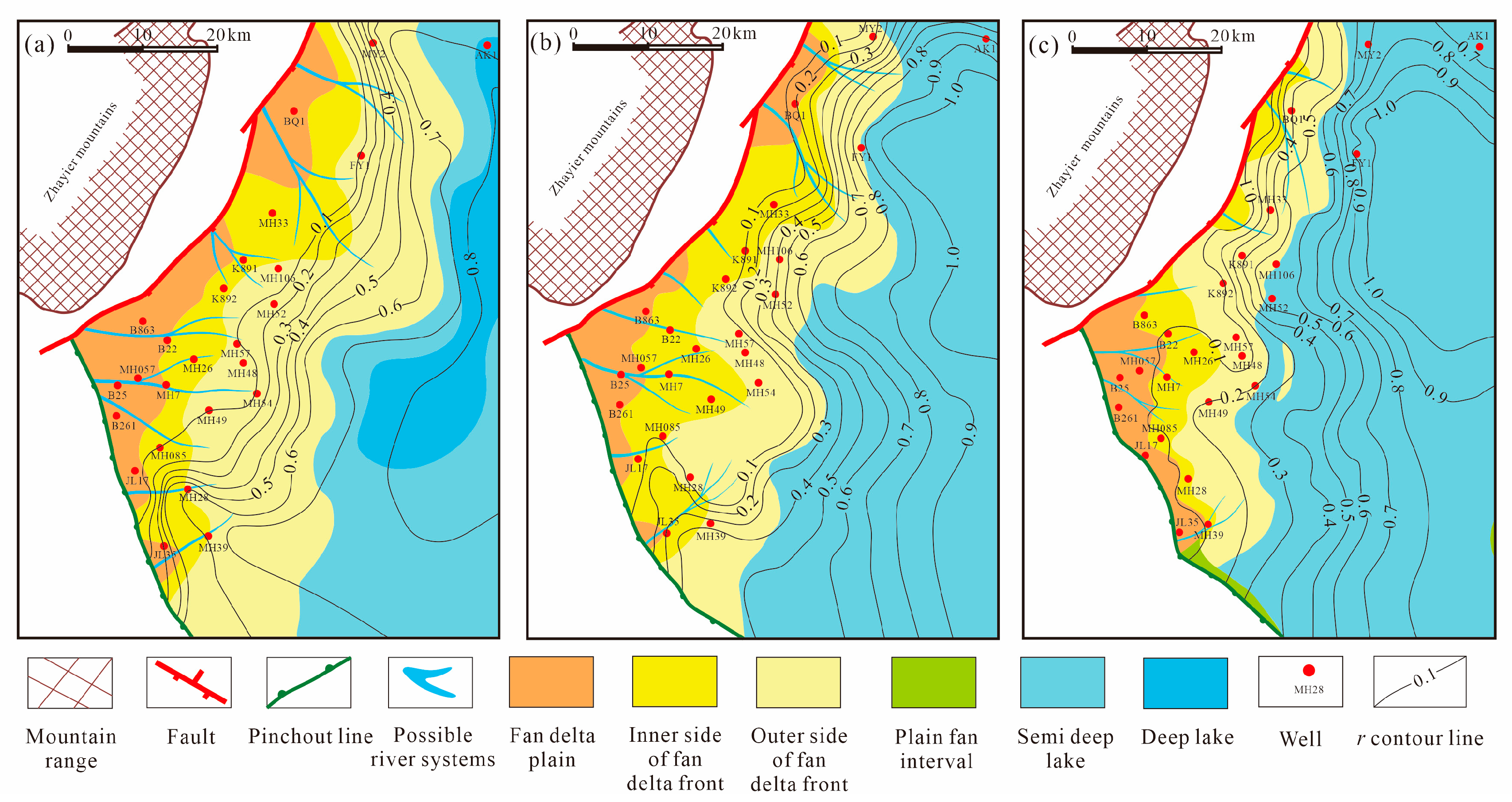
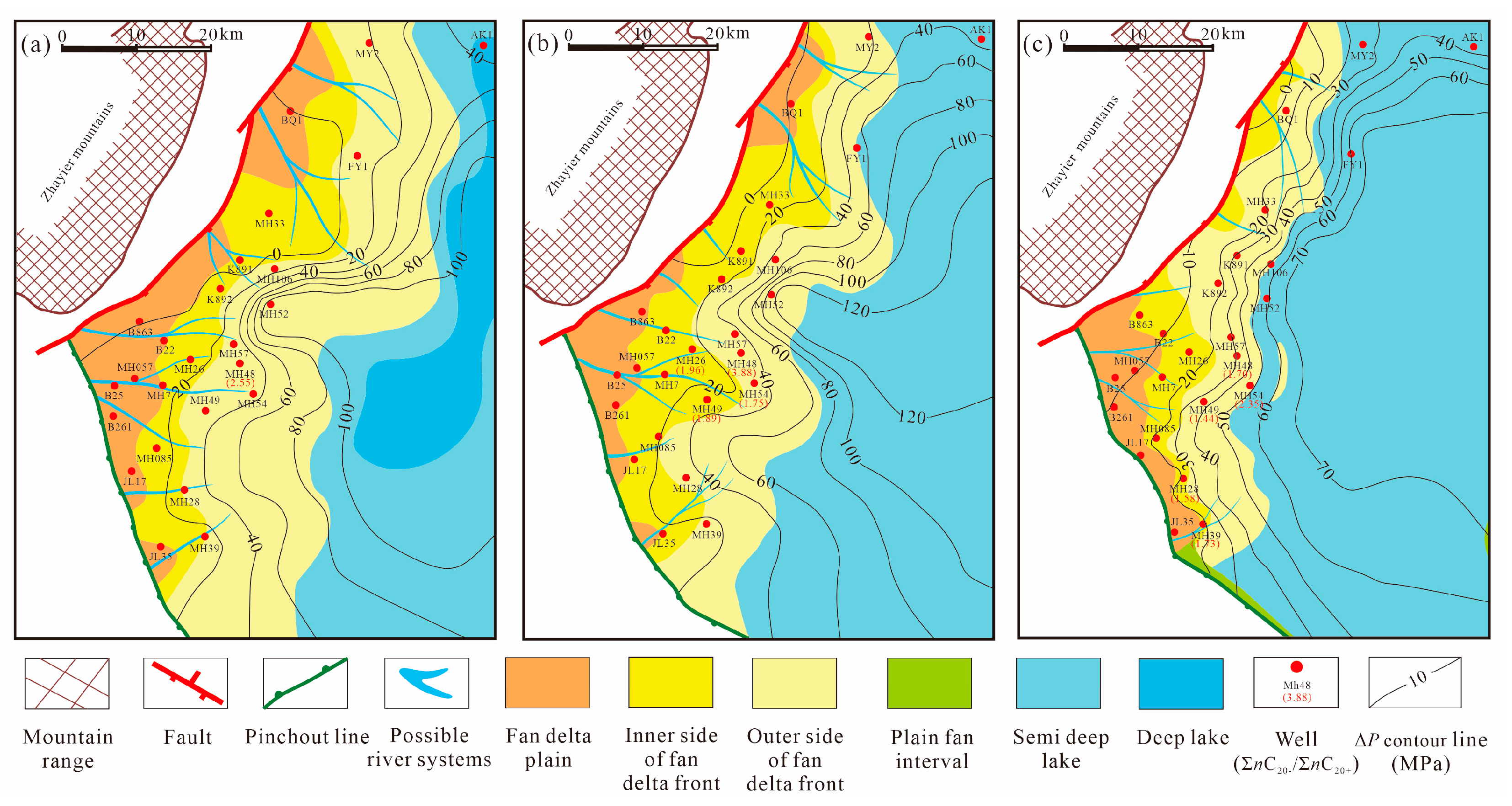
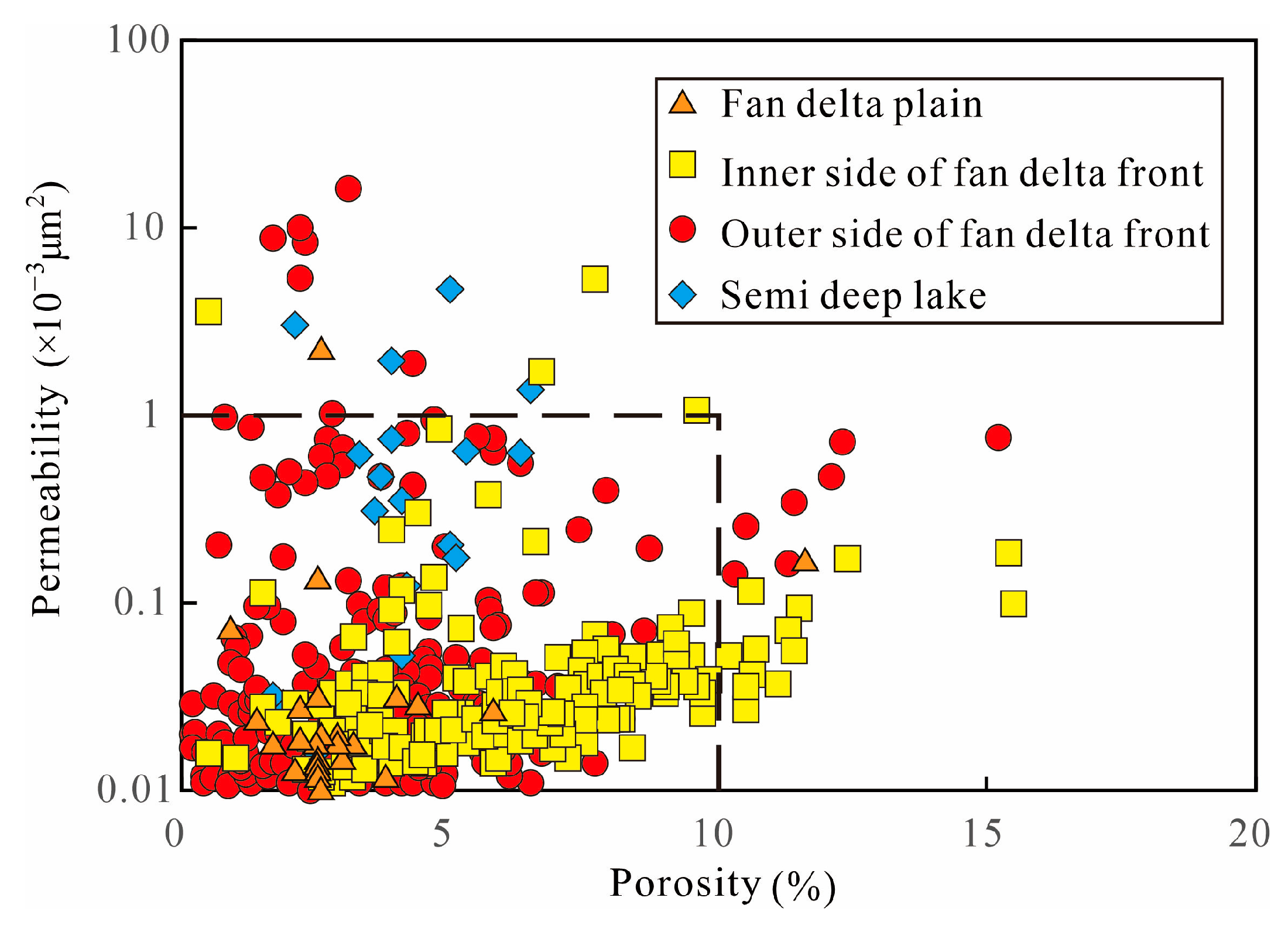
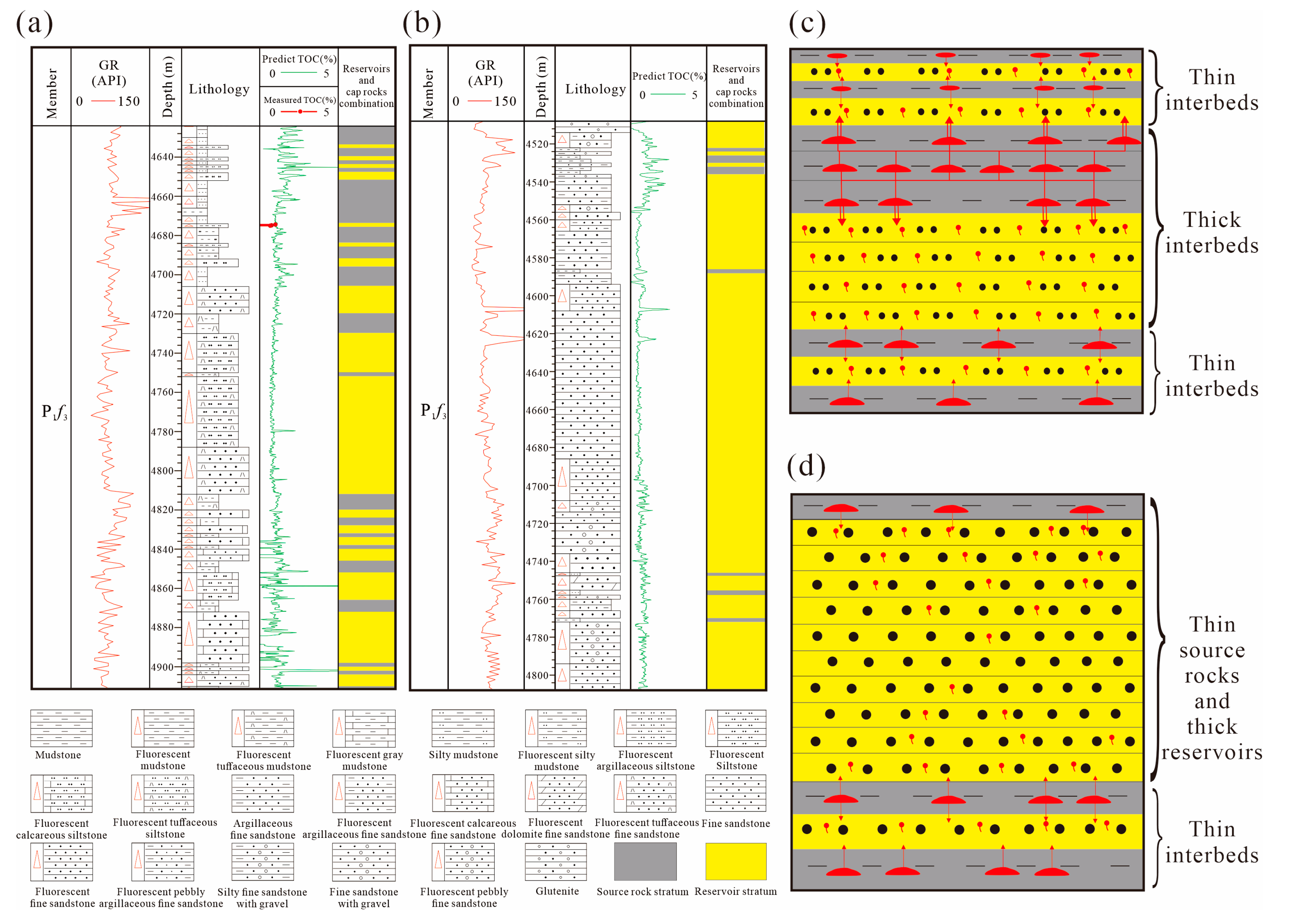
| Well | Depth (m) | Lithology | Measured TOC (%) | Predict TOC (%) | Absolute Error | Relative Error (%) | DEN (g/cm3) | AC (μm/ft) | GR (API) | RI (Ω•m) | SP (mv) | RXO (Ω•m) | CALI (cm) | RT (Ω•m) | CNL (v/v) |
|---|---|---|---|---|---|---|---|---|---|---|---|---|---|---|---|
| MH39 | 5119.14 | Mudstone | 3.34 | 2.56 | 0.78 | 23.26 | 2.48 | 73.514 | 88.227 | 15.197 | −37.247 | 13.85 | 8.365 | 14.557 | 26.566 |
| MH39 | 5119.2 | Mudstone | 3.08 | 2.56 | 0.52 | 16.94 | 2.481 | 75.826 | 86.624 | 11.783 | −37.289 | 11.412 | 8.351 | 11.28 | 27.571 |
| MH39 | 5119.52 | Mudstone | 3.85 | 2.26 | 1.59 | 41.25 | 2.481 | 84.177 | 99.638 | 12.219 | −37.459 | 14.019 | 8.431 | 11.888 | 29.291 |
| MH39 | 5119.85 | Mudstone | 2.13 | 2.36 | 0.23 | 10.63 | 2.491 | 83.484 | 89.551 | 11.5 | −37.786 | 10.541 | 8.507 | 11.588 | 30.374 |
| MH39 | 5120.01 | Mudstone | 1.94 | 2.35 | 0.41 | 21.02 | 2.51 | 81.229 | 81.092 | 12.368 | −37.949 | 9.948 | 8.389 | 12.509 | 29.454 |
| MH39 | 5120.34 | Mudstone | 1.55 | 1.71 | 0.16 | 10.54 | 2.58 | 78.696 | 84.654 | 13.586 | −38.152 | 11.902 | 8.393 | 13.85 | 26.427 |
| MH39 | 5120.64 | Mudstone | 1.02 | 1.43 | 0.41 | 39.94 | 2.612 | 75.158 | 77.572 | 15.56 | −38.394 | 13.125 | 8.434 | 16.089 | 22.428 |
| MH39 | 5121.93 | Mudstone | 0.92 | 1.65 | 0.73 | 79.30 | 2.578 | 79.614 | 85.416 | 9.235 | −38.949 | 7.542 | 8.516 | 9.931 | 26.525 |
| MH39 | 5122 | Mudstone | 1.1 | 1.64 | 0.54 | 49.34 | 2.582 | 80.109 | 83.896 | 9.313 | −39.002 | 7.555 | 8.523 | 9.987 | 26.837 |
| MH39 | 5340 | Tuffaceous mudstone | 0.97 | 1.30 | 0.33 | 34.44 | 2.603 | 58.61 | 77.016 | 6.842 | −64.215 | 7.446 | 8.301 | 7.431 | 9.553 |
| MH39 | 5341.4 | Tuffaceous mudstone | 0.88 | 1.20 | 0.32 | 36.70 | 2.599 | 64.002 | 84.186 | 6.99 | −65.028 | 3.928 | 8.326 | 8.091 | 12.138 |
| MH39 | 5342 | Tuffaceous mudstone | 1.18 | 1.18 | 0.00 | 0.18 | 2.604 | 66.435 | 97.945 | 4.138 | −65.624 | 3.756 | 8.326 | 4.884 | 15.904 |
| MH39 | 5343.81 | Tuffaceous mudstone | 1.38 | 1.71 | 0.33 | 23.72 | 2.58 | 66.292 | 80.69 | 3.843 | −67.775 | 3.128 | 8.396 | 4.734 | 18.414 |
| MH52 | 5286.93 | Calcareous mudstone | 0.87 | 0.87 | 0.00 | 0.20 | 2.699 | 56.639 | 89.119 | 201.977 | −514.49 | 45.147 | 8.856 | 298.042 | 0.161 |
| MH52 | 5287.65 | Calcareous mudstone | 3.01 | 3.13 | 0.12 | 3.90 | 2.511 | 57.047 | 88.462 | 95.924 | −514.192 | 62.994 | 8.717 | 113.204 | 0.106 |
| MH52 | 5287.82 | Calcareous mudstone | 1.79 | 3.14 | 1.35 | 75.39 | 2.533 | 57.99 | 86.685 | 132.886 | −514.134 | 94.123 | 8.669 | 149.564 | 0.123 |
| MH52 | 5288.17 | Calcareous mudstone | 2.48 | 2.67 | 0.19 | 7.51 | 2.558 | 57.89 | 87.46 | 309.97 | −513.461 | 151.995 | 8.568 | 370.723 | 0.129 |
| MH54 | 5138.95 | Tuffaceous mudstone | 1.36 | 1.19 | 0.17 | 12.82 | 2.667 | 59.963 | 79.67 | 18.459 | −315.9 | 18.665 | 8.725 | 17.849 | 0.102 |
| MH54 | 5139.3 | Tuffaceous mudstone | 1.14 | 1.20 | 0.06 | 4.93 | 2.678 | 56.584 | 83.032 | 20.883 | −314.974 | 22.321 | 8.72 | 20.141 | 0.088 |
| MH54 | 5139.5 | Tuffaceous mudstone | 0.85 | 1.32 | 0.47 | 55.81 | 2.672 | 55.264 | 82.774 | 31.361 | −314.765 | 30.78 | 8.72 | 30.446 | 0.078 |
| MH54 | 5139.6 | Tuffaceous mudstone | 1.57 | 1.49 | 0.08 | 5.21 | 2.67 | 54.723 | 79.397 | 57.54 | −314.489 | 50.499 | 8.72 | 56.308 | 0.075 |
| MH54 | 5139.98 | Tuffaceous mudstone | 2.99 | 1.69 | 1.30 | 43.45 | 2.664 | 53.273 | 61.639 | 90.252 | −313.623 | 54.785 | 8.73 | 90.122 | 0.076 |
| FY1 | 5230.96 | Calcareous mudstone | 0.72 | 0.93 | 0.21 | 29.07 | 2.5 | 64.838 | 67.859 | 8.035 | −17.625 | 2.652 | 9.354 | 9.111 | 0.177 |
| FY1 | 5232.71 | Calcareous mudstone | 1.06 | 0.70 | 0.36 | 33.97 | 2.55 | 66.009 | 64.143 | 5.578 | −27.588 | 2.511 | 8.993 | 6.154 | 0.19 |
| MY2 | 4430.14 | Calcareous mudstone | 0.27 | 0.01 | 0.26 | 97.86 | 2.503 | 60.699 | 53.499 | 46.3 | −44.482 | 40.451 | 9.126 | 707.94 | 17.108 |
| MY2 | 4430.48 | Calcareous mudstone | 0.51 | 0.81 | 0.30 | 59.00 | 2.438 | 64.782 | 54.144 | 7.144 | −44.705 | 30.264 | 11.171 | 581.631 | 24.07 |
| MY2 | 4430.79 | Calcareous mudstone | 0.44 | 0.53 | 0.09 | 20.57 | 2.361 | 67.873 | 39.455 | 15.458 | −45.07 | 1.568 | 18.614 | 602.8 | 36.51 |
| MY2 | 4432.02 | Calcareous mudstone | 0.47 | 0.52 | 0.05 | 10.92 | 2.368 | 62.858 | 76.507 | 41.666 | −48.045 | 45.537 | 21.402 | 461.527 | 33.433 |
| MY2 | 4432.13 | Calcareous mudstone | 0.56 | 0.63 | 0.07 | 12.88 | 2.39 | 61.641 | 82.506 | 70.567 | −48.205 | 43.661 | 20.999 | 330.755 | 29.052 |
| Region | Sedsedimentary Facies (N = Number of Samples) | Porosity (%) | Average Porosity (%) | Porosity < 10% (%) | Permeability (×10−3 μm2) | Average Permeability (×10−3 μm2) | Permeability < 1 × 10−3 μm2 (%) |
|---|---|---|---|---|---|---|---|
| South | Fan delta plain subfacies (N = 6) | 2.6~11.6 | 5.37 | 83 | 0.012~2.250 | 0.42 | 83 |
| Inner side of fan delta front subfacies (N = 186) | 0.5~15.5 | 6.28 | 92 | 0.011~0.350 | 0.108 | 98 | |
| Outer side of fan delta front subfacies (N = 184) | 0.2~15.2 | 4.14 | 96 | 0.010~16.100 | 0.205 | 99 | |
| West | Fan delta plain subfacies (N = 21) | 0.9~3.2 | 2.41 | 100 | 0.010~0.137 | 0.026 | 100 |
| Inner side of fan delta front subfacies (N = 14) | 0.2~2.3 | 0.9 | 100 | 0.020~0.200 | 0.05 | 100 | |
| Outer side of fan delta front subfacies (N = 39) | 0.4~4.7 | 2.46 | 100 | 0.012~10.000 | 0.907 | 87 | |
| Semi-deep lake subfacies (N = 22) | 1.7~6.5 | 3.95 | 100 | 0.016~4.690 | 0.708 | 82 |
Disclaimer/Publisher’s Note: The statements, opinions and data contained in all publications are solely those of the individual author(s) and contributor(s) and not of MDPI and/or the editor(s). MDPI and/or the editor(s) disclaim responsibility for any injury to people or property resulting from any ideas, methods, instructions or products referred to in the content. |
© 2023 by the authors. Licensee MDPI, Basel, Switzerland. This article is an open access article distributed under the terms and conditions of the Creative Commons Attribution (CC BY) license (https://creativecommons.org/licenses/by/4.0/).
Share and Cite
Feng, C.; Wang, X.; Bai, S.; Bai, Y.; Zhao, J.; Li, M.; Zhang, Q.; Wang, X. Characteristics of Hydrocarbon-Generating Pressurization in Shale Series of Fengcheng Formation in the West and South of Mahu Sag, the Junggar Basin, China. Processes 2023, 11, 2847. https://doi.org/10.3390/pr11102847
Feng C, Wang X, Bai S, Bai Y, Zhao J, Li M, Zhang Q, Wang X. Characteristics of Hydrocarbon-Generating Pressurization in Shale Series of Fengcheng Formation in the West and South of Mahu Sag, the Junggar Basin, China. Processes. 2023; 11(10):2847. https://doi.org/10.3390/pr11102847
Chicago/Turabian StyleFeng, Chong, Xin Wang, Shuying Bai, Yu Bai, Jiecun Zhao, Meijun Li, Qianqian Zhang, and Xun Wang. 2023. "Characteristics of Hydrocarbon-Generating Pressurization in Shale Series of Fengcheng Formation in the West and South of Mahu Sag, the Junggar Basin, China" Processes 11, no. 10: 2847. https://doi.org/10.3390/pr11102847
APA StyleFeng, C., Wang, X., Bai, S., Bai, Y., Zhao, J., Li, M., Zhang, Q., & Wang, X. (2023). Characteristics of Hydrocarbon-Generating Pressurization in Shale Series of Fengcheng Formation in the West and South of Mahu Sag, the Junggar Basin, China. Processes, 11(10), 2847. https://doi.org/10.3390/pr11102847









